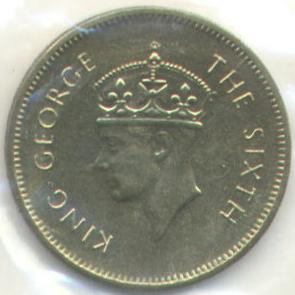
A Royal Proclamation dated 1948 June 22nd, appointed that the words Emperor of India or Indiae Imperator should be omitted from His Majesty's Style and Titles on all coins, medals and seals. Mr. T. H. Paget was commissioned to make plaster casts from the crowned effigy of His Majesty King George VI with the following inscription KING GEORGE THE SIXTH. It was used in the coinage of Ceylon. until his death on 1952 February 6th.
The obverse of the coin carries crowned head to left.

| ||||
| KM119 | Two | Cent | nickel-brass | coin |
| KM120 | Five | Cent | nickel-brass | coin |
| KM121 | Ten | Cent | nickel-brass | coin |
| KM122 | TwentyFive | Cent | nickel-brass | coin |
| KM123 | Fifty | Cent | nickel-brass | coin |
According to Sallay (1986) large quauntities of coins minted for the Central Bank of Ceylon in the early 1950's carried the dates 1943 1944 and 1945 of the dies and punches used by the Board of Commissioners of Currency for minting of its coins.
The original proof coins dated 1951 were struck in the Royal Mint and the proof restrikes in Bombay in fairly large number.
Royal Mint Report for 1959 states that new Master tools for coinages for Ceylon 50c 25c and 10c were made to accord with sample pieces supplied. For the obverse of all denominations reduction-punces of the effigy were prepared from an existing intermediate model and the inscriptions were engraved by hand on the succeeding matrices. For the Reverse matrix was engraved by hand.
Slight differences in the date numerals and native characters on the 10c, 25c and 50c.
In the Minutes of the Metting of the Numismatic Society of Sri Lanka, held in Colombo on 1989 November 19th, it was found that the two distinct types of 50 cent coins differed in almost everything, the crown the face, the letters, the two brances and almost all the other features. In particualar one had 13 dots on either side of the crown on the obverse, while the other had 14 dots. Mr Sallay stated that dies were prepared in London and sent to India in 1951. In 1959 quotes were called both from India and London for the minting of 25 cent and 50 cent coins. London being the cheaper was given the contracts, however the same dies (that were in the Central Bank Custody) were sent to London.
To quote Remick (1968) "The entire 1951 coinage has been restruck in proof condition in fairly large amounts. It is very difficult to impossible to tell the original 1951 proof coins from the restrike. The original issue of 1951 was well struck from new dies. Some of the later restrikes were struck from rusty dies, but this is not so for all restrikes. The coins are lacquered for protection. The 1945 cent was issued in proof condition with the original 1951 proof coins to complete the set. Not cased (150)"
To quote book by Sallay (1986) "To meet the need of numismatics the Central Bank authorized the Government of India to strike `proof' coins with the date 1951 and pack them in presentation cases consisting one each of the -/50 cent, -/25 cent, -/10 cent, -/05 cent, -/02 cent, -/01 cent and sell upto five sets per collector. No record of the exact number of such sets minted and sold is available. ( The one cent piece carried the date 1945 )."
The Dick Ford collection (in Taisei-Baldwin-Gillio Auctions #19 Ceylon 1995 February 23. Singapore lot#240) says the 1945 Bronze Cent (KM111a), is not listed for 1951. Set sold for US$65+10%.
The quotes above seem to indicate that the 1-cent was added to the 1951 proof coins when restruck and was not contained in the original 1951 proof sets.
Krause however adopting Remick say PS1 1951(6) 150* KM111a.119-123. The total set price of $40/- does not match the $15-20 each for the original Proof coins and closer to the $4-5 each for the restrikes.
A quantitative variety in the obverse is the number of dots on each side of the crown on the head of the King. It is either 13 or 14 dots and is recognized to be difference between the India Government Mints in Bombay and Calcutta, and the Royal Mint, London
The Proof set in my collection has 5-coins encased in a flexible plastic
sheet with 6-compartments one of which is sealed but empty.
The crown has 13 dots. The coins my collection and a few others I
have inspected had 13 dots and I am looking for a 14 dots type.
I am trying to confirm which had 13 dots.
Text edited from
* The Coins of the British Commonwealth of Nations
F. Pridmore, London, Spink & Son Ltd., 1960.
* British Commonwealth Coins
Jerome M. Remick, 1971
*Sri Lanka Currency of Recent Times 1938-1985
T. M. U. Sallay, 1986 Central Bank of Sri Lanka, 121 p., ills.